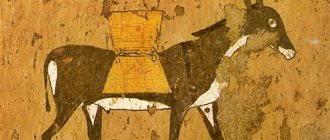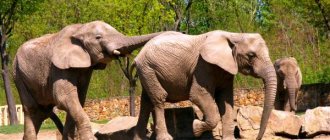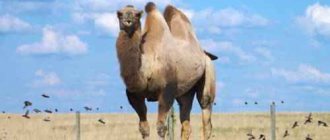Description and origin of the species
The ancestors of llamas lived on the plains of North America about 40 million years ago. Around 3 million years ago, animals migrated to South America as part of the Great Inter-American Exchange, when the Isthmus of Panama first appeared. Even 25,000 years ago, the population in North America was large - llamas lived in the states of California, Texas, New Mexico, Utah, Missouri and Florida. After the Ice Age, llamas disappeared from North America.
The first scientific description of the animal was given by Carl Linnaeus in 1758. Together with alpacas, the scientist attributed llamas to the genus Camel. Since 1800, the animals have been allocated to a separate genus, Lama, along with the guanaco.
There are 4 types of llamas:
- Lama Lama glama
- alpaca Vicugna pacos
- guanaco Lama guanicoe
- Vicugna vicugna
Llama and alpaca are domestic animals, guanaco and vicuna are wild species. Genetic studies have confirmed that the ancestor of the domestic llama is the guanaco, and the ancestor of the alpaca is the vicuña. However, animals interbreed freely with each other, which leads to the appearance of numerous hybrids and blurs the differences between species.
What is the difference between a llama and an alpaca?
The llama is larger than the alpaca and has a more elongated head and rounded ears. The llama grows up to 1.8 meters, the alpaca does not exceed 1 meter in height. Alpaca fur is finer, softer, longer and more valuable, and the color of alpaca wool is richer than that of llama. Similarly, the vicuña (wild alpaca) differs from the guanaco (wild llama) in its more modest size, shorter head and more graceful physique.
Guanaco and vicuna are distinguished by a uniform light brown color interspersed with white. Their domesticated relatives, llamas and alpacas, boast a wider range of colors - white, black, brown, gray and piebald individuals are found.
What does a llama look like?
An adult animal reaches a height of 1.7-1.8 meters at the top of the head, and weighs from 130 to 200 kg. The height of the animal at the withers is about 120 cm. The neck is long and relatively thin, the head is small and set high. The ears are long, pointed and slightly tilted forward. There is no sexual dimorphism in animals, so it is quite difficult to distinguish a female from a male by appearance.
The llama's build is similar to other members of the Camelidae family, but the animal does not have a hump on its back, unlike a camel. Otherwise, llamas are similar to camels in many ways. Animals chew their cud in a similar way and spit it out when they are unhappy. Both llamas and camels have canine-shaped incisors on the top of their jaws and calloused pads on the soles of their cloven hooves as an adaptation to rocky ground. The long and unusually complex intestines allow llamas, like camels, to live on little water.
Alpaca food
Alpaca is a herbivore animal. They feed on grasses, leaves, and almost all types of vegetation. When searching for food, they move very slowly, looking for the most nutritious plants. They need regular watering. They differ from other ruminants by an anatomical feature that gives them an advantage in collecting feed. The alpaca's mouth is similar to a harelip, the incisors are located at an angle, and are constantly growing, like in rodents.
Alpacas are unpretentious and hardy, less demanding of food than the usual sheep. In captivity, they are fed grass and leaves in the summer, and hay, vegetables, bread and oatmeal in the winter. The diet can be the same as that of a horse.
To obtain wool of special quality, livestock breeders add various minerals to the feed. Alpaca reproduction and lifespan.
Where does the llama live?
The llama lives in the western part of South America, in the mountain ranges and at the foot of the Andes mountains, in Chile, Ecuador, Peru, Bolivia, and Argentina. These animals were domesticated primarily for transporting goods in inaccessible mountainous areas. In the wild, vicuyas and guanacos live in the highlands, ranging from 3,200 to 4,800 meters above sea level.
Llamas and alpacas were also introduced to North America and have successfully taken root in the United States.
Character and lifestyle
Llamas are herd animals and live in a herd. The social status of an animal in a herd is constantly changing, especially for males. Conflicts often occur between males, thanks to which the winners successfully move up the social ladder. Fights between males are spectacular - the animals actively spit, butt and ram each other, kicking each other to knock the enemy down.
Fights between females look much less dramatic - females usually limit themselves to spitting at other members of the herd. You can tell how irritated the llama is by spitting. The more angry the animal is, the less processed chewing gum it uses to spit. Despite small skirmishes among themselves, llamas in the same herd take care of each other. Animals instantly respond to an alarm signal given by one of their relatives and prepare to defend the herd.
In the wild, vicuñas and guanacos live in family groups. The group usually includes one male, from 5 to 15 females, and their offspring. The dominant male expels all males older than 1 year from the herd to eliminate competitors. Exiled males create their own herd, or live alone.
Each group lives in its own territory measuring about 18 square kilometers. The size of the territory varies depending on the availability of food. Wild llamas are very shy. Thanks to their acute hearing, animals are constantly on alert and difficult to take by surprise.
When communicating with each other, the lamas chuckle. As an alarm signal, llamas make a sound similar to barking laughter. When an animal is angry or afraid, it moans, sighs, or makes a loud “mwa” sound. When a llama is anxious or unhappy, it folds its ears back. A happy or curious llama, on the contrary, pricks his ears forward.
Sexually excited male llamas make a specific “eagle” sound, reminiscent of gargling, but more buzzing. Males make this sound from the moment of arousal and during sexual intercourse, which lasts from 15 minutes to 1 hour.
Alpaca lifestyle
Alpaca is a herd animal. In the herd there is always a head - a male and up to 10 females. Babies don't count. There is a hierarchy where there is a struggle for ranks and primacy. But all this is not accompanied by strong aggression. They lead a diurnal lifestyle, and rest at night helps digest food and feed absorbed during the day.
Communication between individuals occurs through body language. The tilt and movement of not only the body, but also the ears and neck are taken into account. They avoid danger and try to leave those places where they feel it.
They prefer to graze on a horizontal surface high in the mountains, where there are no predators and the grass is cleaner and lush. They are not afraid of the cold thanks to their fur. They survive well high in the mountains, since thin air does not pose a danger to them.
Reproduction and young
Females reach sexual maturity at 12 months, males only at 3 years. Unlike many other animals, female llamas do not go into heat. Ovulation in a female is stimulated from the outside, and occurs right during mating. Pregnancy usually occurs on the first try. Mating occurs in a prone position and lasts approximately 20-45 minutes, which is very unusual for such large animals.
Pregnancy lasts approximately 350 days, that is, about 11.5 months. Females do not lick their babies because the llama's tongue is too short. The animal can stick out its tongue a maximum of 13 mm, so instead of licking, females sniff and sing to their young.
Llamas try to give birth surrounded by a herd to protect the newborn from predators. Labor takes only about 30 minutes and is usually easy, with females giving birth standing up. As a rule, only one cub is born in one litter, weighing from 9 to 14 kg. Just an hour after birth, the little llama is already standing, walking and sucking mother's milk.
Llama milk has low fat content and a higher content of phosphorus and calcium compared to cow and goat milk. At one time, a llama gives only about 60 ml of milk, so the baby has to feed frequently. Because of this, female llamas are never milked.
Interesting Facts
Llamas and their close relatives are amazing animals. Despite the fact that the first llamas were domesticated many centuries ago, they never cease to amaze ordinary people with their appearance and habits.
Interesting Facts:
Recommended by topic
Tiger Meerkat Horse
- At the age of three, male llamas grow 3 pairs of canine-shaped incisors. They are curved back and very sharp.
- During a fight, male llamas actively bite and headbutt their opponent.
- During the rut, sexually mature males try to bite off the testicles of all rivals in order to eliminate competitors. Because of this feature, farmers have to remove the fangs of adult males.
- Llamas are very smart and are often used as shepherds and guards for sheep. Not every predator or stranger will dare to walk past an adult male llama standing on duty.
- Thanks to their flexible intelligence, llamas perfectly remember commands and are trainable.
- A llama and a camel can have common offspring. But artificially bred hybrids (Kama) cannot reproduce.
- A hybrid of a llama and an alpaca is called a huarizo.
- Vicuna fur is considered the most valuable among the representatives of the family. Items made from vicuña wool are recognized as the most expensive.
- In order to trim wild vicuñas, they are rounded up into herds and driven into a temporary pen. After shearing, the animals are released into the wild. This haircut is possible only once every three years.
- The coat of arms of Peru features a vicuña.
- Alpacas do not have front incisors, so they do not cut grass, but carefully pinch it off with their lips.
- Vicunas are the only members of the family whose front incisors grow throughout their lives.
- Only males are used to carry heavy loads. Female llamas are less hardy and are designed to give birth to offspring.
- For centuries, the llama has been the most popular, and in some places the only, beast of burden in remote areas of the Alps.
- The alpaca is a social animal and cannot live outside the herd. Purchased individuals can become sad and even die from loneliness, so experts advise getting a pair of alpacas at once.
- Surprisingly, male llamas will never carry a load that exceeds 50 kg. They simply refuse to move forward and lie down or sit on the ground. If the driver insists on his own, the lama will simply spit in his face.
- An alpaca, unlike a llama, does not bite or butt its head. Representatives of the species have a softer and more flexible character.
- The indigenous people of the Andes call llamas “silent brothers” and consider them sacred animals.
- Scientists have noticed that communication with alpacas and llamas gives a lasting calming effect, so they are used as therapy animals in nursing homes, schools for underdeveloped children and in hospitals.
- In mountainous areas there is very little solid fuel, so locals use dried llama droppings to make a fire.
- Llamas are very brave and fearless animals. A small herd can ward off coyotes, dogs and even cougars.
How to tame a llama?
The llama needs to be socialized and accustomed to humans only after breastfeeding has ended. In this case, the animal treats the person with curiosity and friendliness. In contrast, llamas that are bottle-fed and tamed to humans too early will be very difficult to handle as adults. If socialized with people too early, adult llamas treat people the same way as their relatives. Early domesticated males often spit, butt and kick people, while females limit themselves to spitting and general unruly behavior.
This condition is called "Lama Berserker Syndrome." The main factors for its occurrence are bottle feeding, too early taming and isolation of the animal from other llamas. As a result, adult llamas do not distinguish humans from their relatives, and try to dominate people. In the most severe cases, males actively bite, kick and attack their owners from behind, attempting to knock the person to the ground.
Castrating males before puberty reduces the chances of berserker syndrome, but neutered males sometimes also exhibit aggressive behavior towards people. Aggressive male llamas with berserk syndrome cannot be retrained, so they are usually euthanized.
However, ordinary llamas without berserker syndrome also often spit at people.
FAQ
Why do llamas spit at people?
In their natural environment, llamas, like camels, use spitting to demonstrate their status and superiority over their opponents. Animals can spit at a rival, an unwanted suitor during the breeding season, or at a predator. Dominant llamas may spit at subordinates if they do not move away from the feeder or block the way. That is, a lama can spit at a person if he suspects his behavior is aggression, a threat to himself or his offspring. Animals can also spit in the face of an overly annoying or noisy person.
Why is a llama called a llama?
Answer: The name of the animal “Auchenis lama”, according to some versions, is considered to be a borrowed word from the German word Lama or French Lama, perhaps the word is taken from the Spanish llama, which comes from the word llama in the Quechua language (Peru).
Llamas in the household
Pet llamas are used by people in the following ways:
- like pack animals . Llamas are still used as pack animals in remote areas of the Andean mountains. Animals can carry approximately 25-30% of their own weight, that is, approximately 27-45 kg, over an average distance of 8-13 km, occasionally walking up to 24 km per day. If the load is too heavy, the llama will not walk; it lies on the ground and spits at the driver.
- for wool . Llama fur is less valuable than alpacas, however, the fine wool from the llama's undercoat is used to make clothing. Coarser and tougher guard hairs are used for the production of carpets, tapestries and ropes.
- for meat . Like other livestock, llamas are also eaten. Only males are occasionally slaughtered for meat; females are used only for breeding. In the US, animal meat is not in demand.
- like herding animals . In the United States, llamas are often used to guard livestock such as goats, sheep and alpacas. Only one herding llama is assigned to the herd - a castrated male. If there are several llamas, they get closer to each other and stop caring for the herd.
- in therapy with animals . Communication with animals reduces pain, reduces stress, helps fight illness and depression. In the United States, llamas are used as therapy animals in hospitals and nursing homes.
Life in captivity
Good disposition ensures excellent breeding in captivity. They always find a language with a person and demonstrate their curiosity and peacefulness. Some owners independently compare them to cats. They are just as sweet and positive, but they can also be shy.
Everyone knows that camels and llamas often spit. This does not apply to alpacas. They may spit, but rarely and only when necessary (to relieve stomach acid). In this case, the spit will never be directed at a person, while a camel is deliberately capable of dirtying someone it does not like.
The cleanliness of the appearance was noticed by everyone. This is how farmers install toilets in their pens. Where all individuals go to relieve themselves.
They love water treatments. They splash around on their own and simply relax in the water.
It has been proven that a child or adult petting and playing with an alpaca relieves stress, calms down and removes all fears.
Population and protection of the species
The llama is a domestic animal that is still actively bred in South America, so the animal population is quite stable. As of 2007, there were more than 7 million llamas and alpacas in South America. About 40,000 more llamas, and about the same number of alpacas, live in the United States.
Wild llamas, vicuña and guanaco, are listed in the International Red Book with the status of a species not causing concern. From the time of the Spanish conquest until 1964, hunting animals in South America was allowed everywhere and was not regulated in any way. Because of this, by the 1960s the vicuña population was on the verge of destruction and had dropped to 6,000 individuals.
The introduction of a ban on hunting, the wool trade and the opening of nature reserves helped restore the population of wild llamas. The vicuna population currently exceeds 350,000 individuals. The ban on trade in vicuña wool has been lifted since 1993. Hunting for wild llama is now permitted only in Tierra del Fuego in Chile.
Behavior
Alpacas are very social creatures. They are gentle and curious, and with training, can make great pets, experts say. According to the FAO, herds often include animals from different species or taxonomic families, such as llamas, goats and sheep. ()
Alpacas spit when they are upset or feel threatened. Experts say they sometimes spit at each other when they compete for food or try to establish dominance. They will not spit at people or bite unless they are offended.
According to Alpaca Ventures, alpacas make a sound like "mmm." However, they also squeal when danger is present and make special sounds when they are excited. Fighting males scream, emitting a hoarse bird-like cry.
All alpacas in a herd use the same area as a toilet, instead of defecating in random places, as many animals do. According to the FAO, this behavior helps control parasites. According to Alpaca Ventures, males often have cleaner dung piles than females. Females usually line up and walk all at once.
Alpacas graze on a farm in Thailand. Native to South America, alpacas are now farmed around the world. (Image credit: bluedogroom/Shutterstock)











